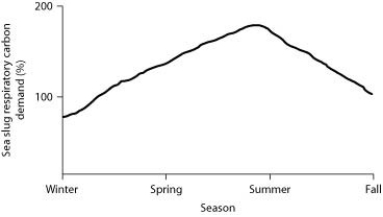The sea slug Pteraeolidia ianthina can harbour living dinoflagellates (photosynthetic protists) in its skin. These endosymbiotic dinoflagellates reproduce quickly enough to maintain their populations. Low populations do not affect the sea slugs very much, but high populations (> 5 × 105 cells/mg of sea slug protein) can promote sea slug survival. 
Percent of sea slug respiratory carbon demand provided by indwelling dinoflagellates.
-In the graph, the percent of the oxygen demand contributed by the dinoflagellates is greater than 100% during much of the year. What is the fate of this "excess" energy?
A) It is dispersed as "entropy" (disorder in the system) .
B) It is saved for producing offspring by the sea slug.
C) It is used to move around the sea bottom.
D) It is used in evaporative cooling by the sea slug.
Correct Answer:
Verified
Q10: You find what you believe is a
Q11: What would be the most effective method
Q18: Q19: The sharp, 2 centimetre-long thorns of the Q24: Molecular studies have changed many of the Q25: The nontaxonomic term sea slug encompasses a Q26: Molecular studies have changed many of the Q26: The sea slug Pteraeolidia ianthina can harbour Q29: Against which hard structure do the circular Q38: Which of the following organisms would you![]()
Unlock this Answer For Free Now!
View this answer and more for free by performing one of the following actions

Scan the QR code to install the App and get 2 free unlocks

Unlock quizzes for free by uploading documents